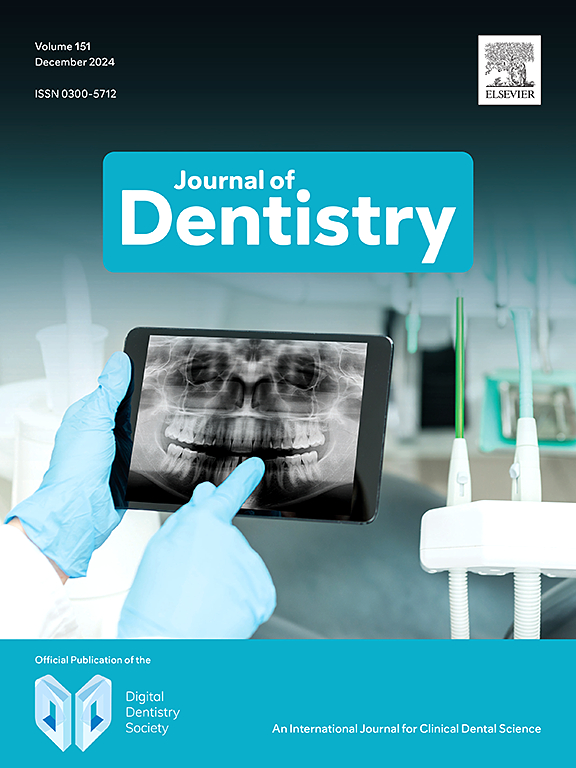无牙颌数字与传统种植印模的准确性:临床比较研究。
IF 4.8
2区 医学
Q1 DENTISTRY, ORAL SURGERY & MEDICINE
引用次数: 0
摘要
目的:本临床研究旨在评估数字和传统种植印模在全无牙颌和下颌骨的准确性。方法:选择1例53岁无牙患者,上颌种植体4颗,下颌骨种植体2颗。进行了10次口腔内扫描(IOS)和每颌常规印模。使用光学(参考数据,每个模型n = 10)和触觉实验室扫描仪(每个模型n = 10)对临床验证的上下石膏模型进行数字化。通过与参考数据比较种植体的精度和线性/角度偏差来评估准确性。统计学分析采用Student’st检验和Kruskal-Wallis检验(α = 0.05)。结果:在上颌骨,种植体1-4之间的IOS线性偏差超过100µm阈值最为显著。在下颌骨,所有线性偏差保持在55µm以下。结论:由于观察到明显的偏差,特别是在上颌,常规印模后的光学扫描仪由于其优越的精度仍然是全无牙病例的首选方法。临床意义:尽管这些偏差的临床意义需要在未来的研究中进行调查,但IOS可能是一种可行的替代方法,特别是对于无牙颌的较短距离。本文章由计算机程序翻译,如有差异,请以英文原文为准。
Accuracy of digital and conventional implant impressions in edentulous jaws: A clinical comparative study
Objectives
This clinical study aimed to evaluate the accuracy of digital and conventional implant impressions in a fully edentulous maxilla and mandible.
Methods
A 53-year-old edentulous patient with four maxillary and two mandibular implants was selected. Ten intraoral scans (IOS) and a conventional impression per jaw were taken. Clinically verified upper and lower plaster models were digitized using both optical (reference data, n = 10 per model) and tactile laboratory scanner (n = 10 per model). Accuracy was evaluated by comparing the precision and linear/angular deviations of the implants with the reference data. Statistical analyses were conducted using Student's t-test and Kruskal–Wallis test (α = 0.05).
Results
In the maxilla, the most significant linear deviations exceeding the 100 µm threshold were found with IOS between implants 1–4. In the mandible, all linear deviations remained below 55 µm. Angular deviations between implants after IOS ranged from 0.01° to 0.40° in the mandible and <0.01° to 1.86° in the maxilla. After tactile scanning, linear deviations did not exceed 100 µm threshold (except in one distance) and angular deviations ranged from 0.04° to 0.54° (mandible) and <0.01° to 2.50° (maxilla). The optical scanner demonstrated significantly higher precision (p < 0.001) compared to the IOS and tactile scanner.
Conclusions
Given the significant deviations observed, especially in the maxilla, the optical scanner following conventional impressions remained the preferred method for fully edentulous cases due to its superior accuracy.
Clinical significance
IOS could be a viable alternative particularly for shorter distances in the edentulous jaw, although the clinical implications of these deviations need to be investigated in future studies.
求助全文
通过发布文献求助,成功后即可免费获取论文全文。
去求助
来源期刊

Journal of dentistry
医学-牙科与口腔外科
CiteScore
7.30
自引率
11.40%
发文量
349
审稿时长
35 days
期刊介绍:
The Journal of Dentistry has an open access mirror journal The Journal of Dentistry: X, sharing the same aims and scope, editorial team, submission system and rigorous peer review.
The Journal of Dentistry is the leading international dental journal within the field of Restorative Dentistry. Placing an emphasis on publishing novel and high-quality research papers, the Journal aims to influence the practice of dentistry at clinician, research, industry and policy-maker level on an international basis.
Topics covered include the management of dental disease, periodontology, endodontology, operative dentistry, fixed and removable prosthodontics, dental biomaterials science, long-term clinical trials including epidemiology and oral health, technology transfer of new scientific instrumentation or procedures, as well as clinically relevant oral biology and translational research.
The Journal of Dentistry will publish original scientific research papers including short communications. It is also interested in publishing review articles and leaders in themed areas which will be linked to new scientific research. Conference proceedings are also welcome and expressions of interest should be communicated to the Editor.
 求助内容:
求助内容: 应助结果提醒方式:
应助结果提醒方式:


